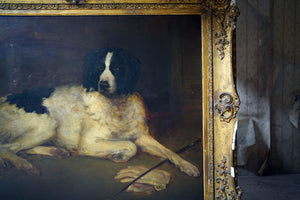SOLD
Origin: English
Period: Regency
Provenance: Unknown
Date: c.1810-15
Height: 36.5”
Width: 16”
Depth: 8.5”
Of diminutive proportions, the Regency period black painted pine dwarf bookcase, with floral gilt decoration to the frieze drawer and front supports and line decoration throughout, having a ruby red painted gallery top, the main section with one adjustable shelf with seven differing height slots, the whole standing on elegant tapering legs and surviving from the first quarter of the nineteenth century.
The bookcase is in sound overall structural condition and there are no issues with stability. In largely untouched condition she is still at the original height and doesn’t appear to have ever had castors fitted. The front legs have some gnarled losses as photographed. There is a charming old depository label to the reverse.
Usually bookcases of this period and form were of waterfall shape which were introduced in the Regency period and the form flourished as part of the overall classic and elegant aesthetic.
Of versatile size, this could be used in any manner of rooms, it’s originality bound for guaranteed admiration.
Period: Regency
Provenance: Unknown
Date: c.1810-15
Height: 36.5”
Width: 16”
Depth: 8.5”
Of diminutive proportions, the Regency period black painted pine dwarf bookcase, with floral gilt decoration to the frieze drawer and front supports and line decoration throughout, having a ruby red painted gallery top, the main section with one adjustable shelf with seven differing height slots, the whole standing on elegant tapering legs and surviving from the first quarter of the nineteenth century.
The bookcase is in sound overall structural condition and there are no issues with stability. In largely untouched condition she is still at the original height and doesn’t appear to have ever had castors fitted. The front legs have some gnarled losses as photographed. There is a charming old depository label to the reverse.
Usually bookcases of this period and form were of waterfall shape which were introduced in the Regency period and the form flourished as part of the overall classic and elegant aesthetic.
Of versatile size, this could be used in any manner of rooms, it’s originality bound for guaranteed admiration.

























